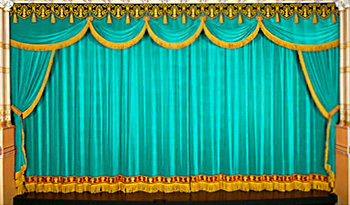 The word javanika or yavanika for curtain finds place in the Natyashastra by Bharata. It occurs in the Natyashastra in connection with the arrangement of musical instruments required in the presentation of plays on the stage. In the preliminaries of the presentation of the Sanskrit plays, a great deal of musical practice was done. The arrangement of musical instruments, fixing the position of musicians, examining of musical instruments, setting of wind and stringed instruments to vocal music, and the entrance of dancing girls were done behind the screen or the curtain.
The word javanika or yavanika for curtain finds place in the Natyashastra by Bharata. It occurs in the Natyashastra in connection with the arrangement of musical instruments required in the presentation of plays on the stage. In the preliminaries of the presentation of the Sanskrit plays, a great deal of musical practice was done. The arrangement of musical instruments, fixing the position of musicians, examining of musical instruments, setting of wind and stringed instruments to vocal music, and the entrance of dancing girls were done behind the screen or the curtain.
The musicians sit in the rangasirsa, between the two doors leading to the green room. Thus the curtain was placed in front of it. After the musical instruments are arranged and tuned, the curtain is drawn aside and dances and recitals are given with the playing of musical instruments and a song in honour of gods is sung. It is stated in the Natyashastra that the curtain is drawn aside on two sides and not pulled up by pulleys. After the curtains are drawn aside, the actors, who are instrumental in bringing about the sentiments, enter the stage. This specifies the fact that when the curtain in between the rangapitha and the rangasirsa is drawn aside, musicians become visible to the spectators.
The ancient Indian theatre had no drop-curtain. This can be explained from the unusual ending of Sanskrit dramas. Sanskrit dramas never ended abruptly as is often the case is modern dramas. The acts, in all Sanskrit dramas, end usually with some portrayal of the time of the day or with some other quiet suggestion to the characters on the stage to make for their exit. This peculiar termination of dramas is due to the non-existence of the drop curtain. The acts ended not with any dramatic incident so as to require the fall of the curtain but with the description of some kind or other. And there is a specific instruction after every act that the actors go out. If there were any drop curtain, there was no need of the actors departing from the stage. The actors could as well be on the stage while the curtain came down. Ancient Indian theatre had only one curtain and few flexible curtains which were used anywhere on the stage.
Thus the curtain is an integral part of theatre. It has an important role to play in enhancing the scenic representation.




















